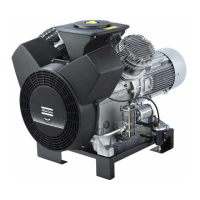2920 7090 00 5
Instruction book
Precautions during installation
1. The dryer must only be lifted using suitable equipment and in accordance with the applicable safety
regulations. Loose or pivoting parts must be securely fastened before lifting. It is strictly forbidden to dwell
or stay in the risk zone under a lifted load. Lifting acceleration and deceleration must be kept within safe
limits. Wear a safety helmet when working in the area of overhead or lifting equipment.
2. Place the dryer where the ambient air is as cool and clean as possible. If necessary, install a suction duct.
Never obstruct the air inlet. Care must be taken to minimize the entry of moisture at the inlet air.
3. Any blanking flanges, plugs, caps or desiccant bags must be removed before connecting the pipes.
4. Air hoses must be of correct size and suitable for the working pressure. Never use frayed, damaged or worn
hoses. Distribution pipes and connections must be of the correct size and suitable for the working pressure.
5. The aspirated air must be free of flammable fumes, vapours and particles, e.g. paint solvents, that can lead
to internal fire or explosion.
6. Arrange the air intake so that loose clothing worn by people cannot be sucked in.
7. Ensure that all piping is free to expand under heat and that it is not in contact with or close to flammable
materials.
8. No external force may be exerted on the air outlet valve. The connected pipe must be free of strain.
9. If remote control is installed, the machine must bear a clear sign stating "Danger: This machine is remotely
controlled and may start without warning".
The operator has to make sure that the machine is stopped and that the isolating switch is open and locked
before any maintenance or repair. As a further safeguard, persons switching on remotely controlled
machines shall take adequate precautions to ensure that there is no one checking or working on the machine.
To this end, a suitable notice shall be affixed to the starting equipment.
10. The machines must be installed in such a way that an adequate flow of cooling air is available and that
the air from the exhaust does not recirculate to the compressor air inlet or cooling air inlet..
11. The electrical connections must correspond to the applicable codes. The machines must be earthed and
protected against short circuits by fuses in all phases. A lockable power isolating switch must be installed
near the compressor.
12. On machines with automatic start-stop system or if the automatic restart function after voltage failure is
activated, a sign stating "This machine may start without warning" must be affixed near the instrument
panel.
13. In multiple compressor systems, manual valves must be installed to isolate each compressor. Non-return
valves (check valves) must not be relied upon for isolating pressure systems.
14. Never remove or tamper with the safety devices, guards or insulation fitted on the machine. Every pressure
vessel or auxiliary installed outside the machine to contain air above atmospheric pressure must be protected
by a pressure-relieving device or devices as required.
15. Pipework or other parts with a temperature in excess of 80˚C (176˚F) and which may be accidentally
touched by personnel during normal operation must be guarded or insulated. Other high-temperature piping
must be clearly marked.
16. If the ground is not level or can be subject to variable inclinations, consult the manufacturer.
Also consult following safety precautions: Safety precautions during operation and Safety
precautions during maintenance.
These precautions apply to machinery processing or consuming air or inert gas. Processing
of any other gas requires additional safety precautions typical to the application which are
not included herein.
Some precautions are general and cover several machine types and equipment; hence
some statements may not apply to your machine.

